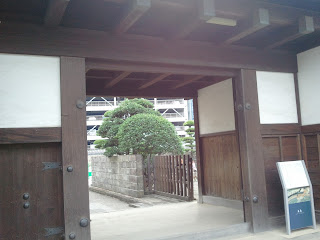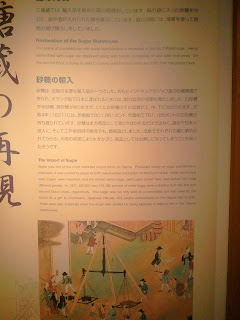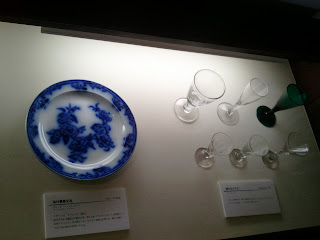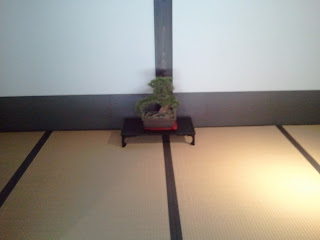Also while these have nothing to do with the rest of the tour here are some shots of two cannons from the Dutch East India Company, the large "A" indicates they were made in Amsterdam. Also there was this early sun dial on display.
Below is a picture of the oldest protestant seminary in Japan, it was built in 1878, which was after the reopening of Japan. One of the promises the Dutch made in order to keep trade is that they were not interested in proselytizing (converting people to their faith), so there was no such structure in the days of the Tokogawa Shogunate.
This monument was erected by Siebolds (the island's physcian) to honor his two predecessors: Kaempfer and Thunberg. Dejima was closed, so people could not leave the island to seek medical care or anything else. They could only leave by ship and would often remain on the island for nearly half a year.
This is the Nagasaki International Club, built in 1903, again after the end of the isolation, as a meeting place for friendly exchange between the Japanese and foreigners. It showcases some games played during the era and some of the original tiles and items from the period, as well as local trade items.This game (I'm sorry I do not know what it is called) was interesting, you set the metal pole at one end and use the sticks to each hit your ball at it. Once you have both done that you remove the pole and try to knock the other person's ball out through one of the holes you see along the side. They also had better known games like backgammon and checkers.
This is the dragon head used for the Kunchi festival which I will be attending the second week in October.
I apologize that these are upside down, and for any future photos that are upside down, google thinks it is being helpful when it auto-rotates pictures and I have not found a way to correct it, it is rather annoying.
I also apologize for not being able to capture the whole building, my back was literally against the wall when I took this, things are a little cramped on this tiny island, it gave me a sense of what it must have felt like to live there.
This next building is inside the stone warehouse, again erected after Japan was open in the mid 1800s. It shows many artifacts excavated on Dejima and has some displays on the reconstruction. I did my best to included kiosks when helpful and only took pictures of distinct and interesting items, but there was too much to get photos of everything.
Next is the main gate, it is not in its original position as a river is flowing through where it once was, but it was still great to stand there and look across the gap and realize that in those days that was as close to Japan as you were ever going to get.
From the Dejima side
Looking across the river to Nagasaki
View from the front
This is where the bridge and gate once were
Next we visited another stone warehouse constructed after the reopening of Japan there wasn't much to see there, it had been set up to do a video presentation.
Next was the Head Clerk's Quarters which featured items detailing western knowledge that came through Dejima as well as some ledgers from the period. Static electricity generator
This was a model of the universe
Some form of clock
This was a bell tower located just outside the clerk's office.
Next we entered warehouse No. 3 that existed at the time, although restored. The warehouse held sugar sacks; sugar was one of Japan's most important imports.
Also here are some staff dressed as a watchman and samurai, and a picture of my roommate and I since I'm almost never in any of my pictures.
Warehouse No. 2 was used for the storage of imported sappan wood, but currently displays the goods both imported and exported from Dejima. This first picture shows the details of how Japanese walls were constructed.
After that we checked out the Deputy Factor's Quarters, this was the home of the trading post's deputy factor of the dutch factory on Dejima. Most of the rooms were empty with descriptions of what the rooms contained. My personal favorite was the library without books or shelves, I guess everything was checked out. What is pictured is what they had on display.
This is the kitchen, for the whole island, they must have been busy.
Next was the building that housed the Japanese officials who handled the clerical work on Dejima. These administrators were chosen from influential men who had built Dejima.
Near the end of our adventure we came to the Chief Factor's Residence. This was the largest building on Dejima, not only did it serve as the residence for the Chief Factor, but was also equipped to entertain officials and dignitaries who visited Dejima. The first floor had displays from the period, the second floor was furnished to period specifications to show living conditions on Dejima.
Finally we came to the Sea Gate, this was the doorway that connected Japan and the outside world. There were two door (which you can see) the Northern door (right) was the gate that exports went out through while imports came in the Southern door (left).
I hope you enjoyed the look at Dejima. I continue to be amazed that so much ancient history exists all around me. Most of the things I have seen date back before America was even founded.



































































































































No comments:
Post a Comment